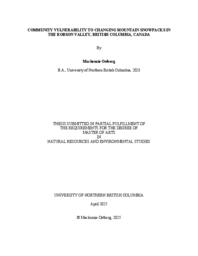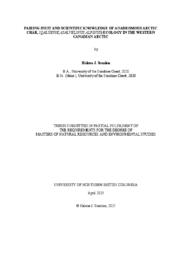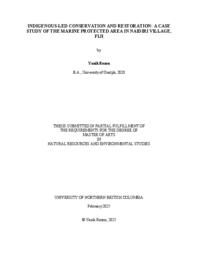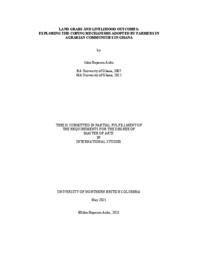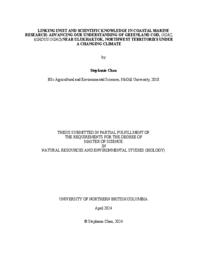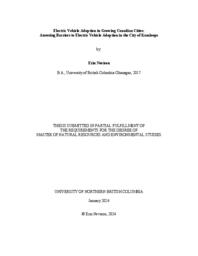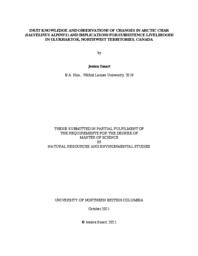Pearce, Tristan
Person Preferred Name
Tristan Pearce
Related Works
Content type
Digital Document
Origin Information
Content type
Digital Document
Origin Information
Content type
Digital Document
Origin Information
Content type
Digital Document
Description / Synopsis
Large-scale land acquisitions worldwide evoke controversy due to its impact on communities. This thesis employs the Sustainable Livelihoods Framework to examine the coping mechanisms adopted in host communities to cope with the impact of land grabs on livelihoods. The study adopts an exploratory approach using mixed-methods design to arrive at the findings. The thesis finds the effect of land grabbing on communities to be negative. This thesis also finds that the alternative livelihood activities people have resorted to in response are not sustainable. Further, it finds that the regulatory and institutional regime guiding these land transactions has done little to assist the people to cope well with the adverse outcomes of land grabs. These findings point to the need for the establishment of precise timelines for compensation to affected people. Also, there is the need to involve the people in the decision-making process from project planning to implementation.
Origin Information
Content type
Digital Document
Description / Synopsis
The Arctic is warming at an unprecedented rate, with implications for the marine ecosystem and species that are important for the tradition, culture, and livelihoods of Indigenous people. Inuit in the western Canadian Arctic have identified a need to better understand the impacts of a changing climate on coastal marine species important for subsistence. Greenland cod, ogac, (Gadus ogac) are found in the coastal marine ecosystem and are reportedly experiencing changes in population dynamics in recent years. In this thesis, I present findings from Inuit and scientific knowledge of Greenland cod as a means of linking knowledge systems to advance our understanding of this species and discuss the implications for Inuit livelihoods under a changing environment. The objectives of this research were to: (1) investigate the adaptation potential of Greenland cod, (2) document Inuit knowledge of this species, and (3) examine the cumulative findings of Greenland cod research and discuss the potential impacts of shifting marine resources on livelihoods in the Inuvialuit Settlement Region. I measured individual specialization-generalization of morphological and habitat-trophic traits from Greenland cod collected along the marine coast near Ulukhaktok, Northwest Territories, NT, in the western Canadian Arctic. I then used this information to elicit discussion on their morphology, feeding, and movement behaviour with key knowledge holders in Ulukhaktok. Scientific findings from this project suggest that Greenland cod are overall generalists but display a range in feeding behaviours for two identified morphotypes. These findings highlight the importance of maintaining trait variation to conserve biodiversity while promoting population resilience in wild fish populations. Inuit knowledge holders were able to build a rationale for some of the phenomena observed and identify early signs of ecosystem change. Linking Inuit and scientific knowledge was a two-way process in which the knowledge systems built off one another to inform the next steps in the research process and interpret the findings more holistically. The cumulative findings advance our understanding of the baseline ecology of this species and intend to inform the design of future research using Inuit and scientific knowledge to generate enriched findings. The knowledge gained and lessons learned from this study can serve as a tool for establishing additional conservation efforts that may be required in the future to ensure a sustained Arctic marine ecosystem can continue to support Inuit subsistence and livelihoods.
Origin Information
Content type
Digital Document
Description / Synopsis
Greenhouse gas emissions from transportation are a significant contributor to climate change. An effective method of reducing these transportation emissions is to electrify transportation. Local governments are creating electric vehicle policies to increase electric vehicle adoption in their communities. The City of Kamloops released their EV Strategy to encourage local electric vehicle uptake in 2020 but encountered barriers to local electric vehicle adoption such as a lack of charging infrastructure, a hesitancy to new technology, and the high prices of EVs. There is no significant research on EV adoption and barriers within a smaller city, regional hub, or Canadian context. To address this, I conducted a content analysis, literature review, and key informant interviews with six stakeholder groups in Kamloops to assess the perceived barriers to EV adoption. My research compares the perceived barriers within the context of Kamloops and provides policy solutions to the City of Kamloops to overcome these barriers and reduce transportation emissions. The City should continue to prioritize EV adoption through public education campaigns, encourage the building of charging stations, and focus on densification for an overall reduction of emissions and to provide convenient places for EV drivers to charge their vehicles.
Origin Information
Content type
Digital Document
Description / Synopsis
This thesis examines how rural communities are at risk to wildfire hazards through a case study of the Robson Valley, British Columbia, Canada. The research is guided by a vulnerability approach, which conceptualizes risk as a function of how a community is exposed and sensitive to a hazard and its capacity to adapt. Data were collected using semistructured interviews with policymakers, forest professionals and emergency managers alongside community meetings in three rural areas, participant observation, and analysis of secondary sources. The findings show that while most communities in the Robson Valley are not directly at risk from extreme wildfire hazards, they are indirectly exposed and sensitive to secondary and tertiary impacts, due to a single power transmission and road transportation route, that are both highly exposed to wildfire hazards. The centralization of government services has led to a change in the ways that wildfires are suppressed, which can be incongruent with diverse land values and attitudes about responding to hazards held by longtime residents and local First Nations. This thesis concludes with recommendations for how to better engage rural communities in fire prevention and suppression including the creation of a community champion position and improved legislation allowing for the participation of rural residents in fire suppression operations.
Origin Information
Content type
Digital Document
Description / Synopsis
After over 100 years of operation, the Norman Wells Oilfield located in the Northwest Territories is beginning the process of closure and reclamation. In negotiating the Sahtú Dene and Métis Comprehensive Land Claim Agreement (1994), Sahtú people have gained more power over environmental decision-making, including directing the goals and outcomes of reclamation projects. A case study approach was used to collect qualitative data over 8 weeks in Fort Good Hope, Northwest Territories and 3 days in Norman Wells, Northwest Territories. Data were collected through 41 semi-structured interviews using open-ended questions with Sahtú people and key informants and an analysis of past engagement records to examine the structures and processes for how Sahtú Dene and Métis have been engaged in the Norman Wells Oilfield project throughout history, and identify opportunities for their meaningful involvement in remediation, reclamation, and monitoring in the future. Findings reveal that past engagement and consultation from Imperial Oil with the Sahtú people has been culturally inappropriate. This has resulted in a loss of trust, violation of Dene principles of reciprocity, and overall ineffective communication. These research findings are intended to contribute to the conversation about the Norman Wells Oilfield closure and reclamation, as well as broader discussions on Indigenous peoples' involvement in environmental reclamation after resource extraction.
Origin Information
Content type
Digital Document
Description / Synopsis
This thesis documents and examines recent changes observed in anadromous Arctic char (Iqalukpik) (Salvelinus alpinus) in Ulukhaktok, Northwest Territories, Canada, including how these changes are being experienced and responded to by community members. Ulukhaktomiut identified a need to document their knowledge and observations of Arctic char to help inform comanagement. The analysis of 20 semi-structured interviews with Ulukhaktomiut revealed six main concerns about Arctic char linked to changes arising in the local environment: (1) presence of salmon, (2) increasing temperature, (3) inconsistent sea and lake ice conditions, (4) changing weather patterns, (5) fluctuating water levels, and (6) the recent presence of tunicates in the ocean. Ulukhaktomiut respond to these changes at the individual and community levels, including altering fishing practices and temporarily halting commercial fishing. The results show that Ulukhaktomiut are astute observers of their local environment and are able to share highly detailed knowledge and observations of Arctic char. Environmental changes are emerging quickly, and there is a great deal of uncertainty among Ulukhaktomiut about why these changes are occurring and what impact they may have on Arctic char. Fisheries management structures will need to be flexible and responsive to ongoing local observations and the best available science to sustain a viable Arctic char fishery now and into the future.
Origin Information

